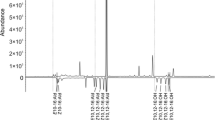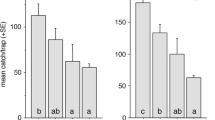Abstract
Several sympatric lepidopteran species feed on maize plants, and the different components of their species-specific female sex pheromones may play a role in attracting conspecifics and/or deter heterospecific males. In this study, we analyzed the content of Mythimna unipuncta pheromone glands and tested the response of males to components of their own pheromone blend and that of Sesamia nonagrioides in the wind tunnel. Whole pheromone glands, and lures where (Z)-9-hexadecenyl acetate, Z)-11-hexadecen-1-ol or (Z)-9-hexadecenyl acetate + (Z)-11-hexadecen-1-ol were added to the major component, (Z)-11-hexadecenyl acetate, elicited significantly higher responses by M. unipuncta males than lures with main component alone, although the levels varied with concentration. In the field a rather different outcome was observed, as the addition of other compounds found in the female pheromone gland did not improve trap catch over lures with only (Z)-11-hexadecenyl acetate. The addition of (Z)-11-hexadecenal, a compound of the S. nonagrioides pheromone, to (Z)-11-hexadecenyl acetate significantly reduced attraction of M. unipuncta males both in the wind tunnel and in the field, as well as the number of sympatric clover cutworm, Discestra trifolii, under field conditions. The addition of (Z)-9-hexadecenyl acetate, a minor component of the M. unipuncta pheromone blend, reduced the number of S. nonagrioides captured in field traps that were baited with the S. nonagrioides lure. The significance of such inhibition in the reproductive isolation of sympatric species that attack maize is discussed.






Similar content being viewed by others
References
ALBAJES, R., CANELA, R., EIZAGUIRRE, M., RIBA, M., and GUERRERO, A. 1988. (Z)-9-Tetradecen-1-ol an attractant for Athetis hospes Freyer. Mediateurs chimiques, comportement et systèmatique des Lepidoptères. Applications en agronomie. Les colloques de l’INRA, nº 46:55–58
BATISTA-PEREIRA, L.G., STEIN, K., DE PAULA, A.F., MOREIRA, J.A., CRUZ, I., FIGUEIREDO, M.L.C., PERRI, J., Jr., and CORRÊA, A.G. 2006. Isolation, identification, synthesis, and field evaluation of the sex pheromone of the Brazilian population of Spodoptera frugiperda. J. Chem. Ecol. 32:1085–1099
DAVID, C.T. and BIRCH, M.C., 1989. Pheromones and insect behaviour, pp. 17–35, in A. R. Jutsum and R. F. S. Gordon (eds.). Insect Pheromones in Plant protection, Wiley, Chichester.
EIZAGUIRRE, M., ALBAJES, R., LÓPEZ, C., SANS, A., and GEMENO, C. 2007. Inhibition of pheromone response in Sesamia nonagrioides by the pheromone of the sympatric corn borer, Ostrinia nubilalis. Pest Manag. Sci. 63:608–614.
EIZAGUIRRE, M., SANS, A., LÓPEZ, C., and ALBAJES, R. 2002. Effects of mating disruption against the Mediterranean corn borer Sesamia nonagrioides on the European corn borer Ostrinia nubilalis. IOBC/WPRS Bulletin 25:59–67.
FARINE, J.P., FRÉROT, B., and ISART, J. 1981. Facteurs d’isolament chimique dans la sécrétion phéromonale de deux Noctuelles Hadeninae: Mamestra brassicae (L.) et Pseudaletia unipuncta (Haw.). C.R. Acad. Sc. Paris, t. 292:101-104
FREROT, B., MALOSSE, C., and CAIN, A.H. 1997. Solid-phase micro extraction (SPME): a new tool in pheromone identification in Lepidoptera. J. High Res. Chromatog. 20:340–342.
GEMENO, C., SANS, A.; LÓPEZ, C., ALBAJES, R. and EIZAGUIRRE, M. 2006. Pheromone antagonism in the European corn borer moth Ostrinia nubilalis. J. Chem. Ecol. 32(5):1071–1084
GERMINARA, G.S., ELGARGOTI, A., DE CRISTOFANO, A., and ROTUNDO,G. 2007. Female sex pheromone of Sesamia cretica: chemical and behavioural evidence of a three component blend. Entomol. Exp. Appl. 125:213-219
GOMEZ, K. A. and GOMEZ, A. A., 1984. Statistical procedures for agricultural research, 2nd ed. Wiley, New York.
GREENFIELD, M.D. 2002. Signalers and receivers, mechanisms and evolution of arthropod communication. Oxford University Press, Oxford, UK, p. 45.
HAYNES, K.F. and BIRCH, M.C. 1985. The role of other pheromones, allomones and kairomones in the behavioural responses of insects, pp. 225–255, in G. A. Kerkut and L. I. Gilbert (eds.). Comprehensive Insect Physiology, Biochemistry and Pharmacology, vol. 9, Pergamon, London.
KAMM, J.A., MCDONOUGH, L.M., and GUSTIN, R.D. 1982. Armyworm (Lepidoptera: Noctuidae) sex pheromone: Field tests. Environ. Entomol. 11:917–919.
MCDONOUGH, L.M., KAMM, J.A., and BIERL-LEONHARDT, B.A. 1980. Sex pheromone of the armyworm, Pseudaletia unipuncta (Haworth) (Lepidoptera: Noctuidae). J. Chem. Ecol. 6:565–572
McNEIL, J. N. 1991. Behavioral ecology of pheromone-mediated communication in moths and its importance in the use of pheromone traps. Annu. Rev. Ent. 36:407–430.
MUSTAPARTA, H. 1997. Olfactory coding mechanisms for pheromone and interspecific signal information in related moth species, pp. 141–164 in Advances in Insect Chemical Ecology, Cardé R and Millar JG (eds.), Chapman and Hall, New York.
SANS, A., RIBA, M., EIZAGUIRRE, M., and LOPEZ, C. 1997. Electroantennogram, wind tunnel and field responses of males Mediterranean corn borer, Sesamia nonagrioides, to several blends of its pheromone components. Entomol. Exp. Appl. 82:121–127.
SHOREY, H. H. and HALE, R. L. 1965. Mass-rearing of the larvae of nine Noctuid species on a simple artificial medium. J. Econ. Entomol. 58:522–524.
SRENG, I., MAUME, B., and FRÉROT, B. 1985. Analysis of the pheromonal secretion of virgin females of Sesamia nonagrioides (Lef.) (Lepidoptera, Noctuidae). C. R. Acad. Sci. Ser. 3. 301:439-442.
STATGRAPHICS. 1997. Statgraphics Plus, version 3, Manugistion; Inc. Rocville, MD.
STECK, W.F., UNDERHILL, E.W., and CHISHOLMN M.D. 1980. Trace components in Lepidopterous sex attractants. Environ. Entomol. 9:583–585.
STECK, W.F., UNDERHILL, E.W., BAILEY, B.K., and CHISHOLMN M.D. 1982. A 4-component sex attractant for male moths of the armyworm, Pseudaletia unipuncta. Entomol. Exp. Appl. 32:302–304.
TURGEON, J.J., MCNEIL, J.N., and ROELOFS, W.L. 1983. Field testing of various parameters for the development of a pheromone-based monitoring system for the Armyworm, Pseudaletia unipuncta (Haworth) (Lepidoptera: Noctuidae). Environ. Entomol. 12:891–894.
Acknowledgments
We thank Joan Safont from UdL-IRTA, who contributed at various times to our research and to Jeremy McNeil for editorial comments. This research was funded by Spanish Research Agency CICYT, AGL2005-06485.
Author information
Authors and Affiliations
Corresponding author
Rights and permissions
About this article
Cite this article
Eizaguirre, M., López, C., Sans, A. et al. Response of Mythimna unipuncta Males to Components of the Sesamia nonagrioides Pheromone. J Chem Ecol 35, 779–784 (2009). https://doi.org/10.1007/s10886-009-9662-0
Received:
Revised:
Accepted:
Published:
Issue Date:
DOI: https://doi.org/10.1007/s10886-009-9662-0




